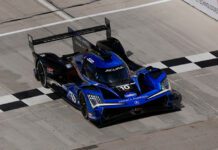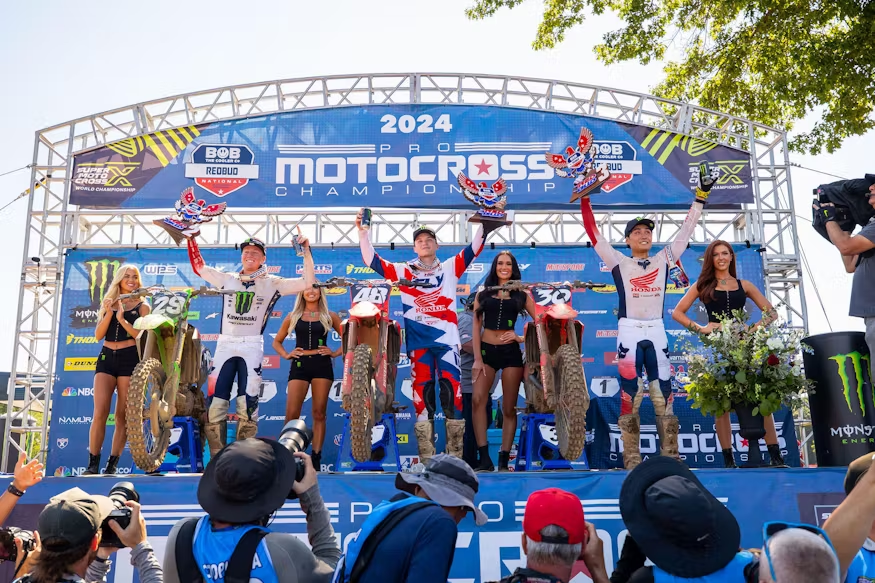The Monster Energy AMA Supercross Series shed some light on its protocols for the final seven races of the season, which will include COVID-19 testing for everyone on site.
During a Friday afternoon news conference conducted over Zoom with a few dozen media outlets, Dave Prater, the senior director of Two Wheel Operations at Feld Entertainment, said Supercross has been approved to have 900 people (which includes riders, teams, series officials, media and local venue workers) within the perimeter of its seven events at Rice-Eccles Stadium in Salt Lake City, Utah.
All will sign a health and safety commitment, complete a questionnaire and undergo COVID-19 testing in Utah, including about 800 traveling from out of state for the seven events that will be held between May 31 and June 21. The state health department will conduct the drive-through testing in Salt Lake City with a turnaround time of 48 hours. Test results will be emailed, and a negative result will be required to enter the Rice-Eccles Stadium perimeter.
If someone tests positive, they can be retested within 72 hours if they don’t have a temperature over 100.4 degrees. If the second test is negative, they’ll be admitted. Another positive test would mean a 14-day quarantine.
“If an athlete tests positive, it’ll be treated like a concussion or anything else,” Prater said. “They’ll sit out.”
The policy will set Supercross apart from NASCAR, which will return Sunday at Darlington Raceway, and IndyCar, which is back on track June 6 at Texas Motor Speedway.
Those series, both of which also are planning to have roughly 900 on site, are planning health screenings for admittance to their races but not COVID-19 tests. NASCAR cited a lack of testing availability as a reason.
Prater said Supercross also didn’t want to detract from public testing and has been assured by Utah officials that it won’t.
“There were a few of states and venues we were speaking to that initially had told us we wouldn’t have to do the COVID-19 testing but as we got closer, it was 100%,” Prater said. “As PBR did an event a few weeks ago and UFC last weekend, I think it almost goes without saying that sporting events will require this for the near, foreseeable future.”
After securing a negative COVID-19 test result on arrival in Utah, Supercross riders and team members won’t need to be retested during the three-week stretch of seven races unless they leave the state. They will be permitted to stay at hotels, houses or in motorhomes while in Salt Lake City, and there won’t be constant monitoring or tracking of their movements.
“It’ll be tough as far as the cadence of the races to leave and come back,” Prater said. “As far as tracking athletes, they’ll sign a health and safety commitment, and we’ll take them at their word. If you leave the state and come back, obviously if it’s a flight, we’ll know. Other than that, we’ll take them at their word.”
Supercross also will require daily temperature checks prior to entering the event perimeter. Facemasks are required at all times on site, and social distancing will be employed.
Other notes from Supercross’ hourlong news conference:
–Because all seven races are being held without fans, which is Supercross’ main source of revenue, Prater said the points fund was reduced by an average of 22.5 percent per position and race purses for the last seven rounds were reduced 17.5 percent.
“For Feld Motorsports, that’s our main source of revenue is the fans,” Prater said. “We’re doing this as stewards of the sport and for the overall health of the Supercross world and industry. It’s going to be a challenge and has been a challenge, but it’s been a desire from Day 1 to get back to racing. We’d prefer we had fans, but given the current circumstances, we’ll do our best with what the situation presents and move forward.”
–Prater said there will be a different track diagram for each race. “With a two-day gap between some of the races, it’s a tight turnaround,” he said. “You might not see as different a track as you would from Indy to Salt Lake. But it will be a different track. The lanes will be the same but with different obstacles.”
–Supercross considered venues in four other states before settling on Salt Lake City. “It came down to the green light and who would give it to us first,” Prater said. “It helps to have longstanding relationships with the sports commission and governor. We worked our tails off to come up with a plan to keep everyone safe and the residents of Utah safe. That was it. That tipped the scale. Other states worked just as hard, it ended up Salt Lake was one to give us the green light first.”
–If for some reason the final seven races can’t be completed, Prater said the championship would be determined at whatever point is reached.
–Though he declined to identify, Prater said Supercross had been sharing its plans with other professional sporting leagues and racing series.
“This whole environment has really pulled everyone together within the industry, not only motorcycling but the sports industry in general,” he said. “We’ve been in communication with multiple leagues, shared our plans and shared their thoughts and ideas.
“But we’re letting the health departments, the CDC and governor’s offices lead the way as far as the plans go. There’s some great insight from other leagues and vice versa. A lot of leagues are watching NASCAR this weekend and us the following weekend. We’ll share whatever we need and help wherever we can.”

















































